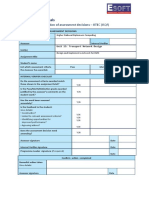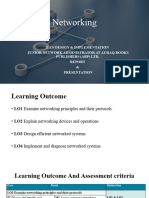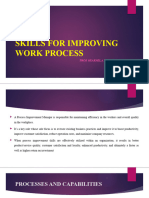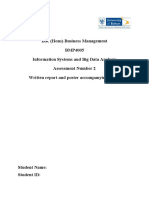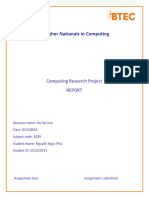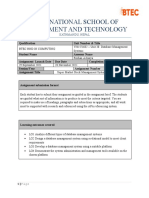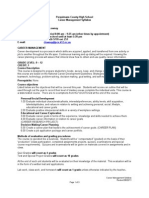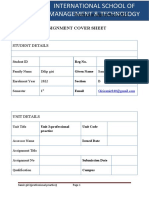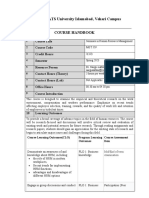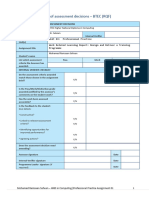0 ratings0% found this document useful (0 votes) 320 views9 pagesUnit 1 Professional Practice in The Digital Economy
Professional Practice in the Digital Economy
Copyright
© © All Rights Reserved
We take content rights seriously. If you suspect this is your content,
claim it here.
Available Formats
Download as PDF or read online on Scribd
Unit 1: Professional Practice in the
Digital Economy
Unit code F/618/6250
Unit type Core
Unit level 4
Credit value 15
Introduction
The rapid pace of technological change and development is transforming the way we
work. The World Economic Forum highlights that in a world of increasing automation,
where smart technologies take on routine tasks there is a need for individuals who
can solve complex problems, who are able to communicate well and be resilient,
creative and innovative. In the workplace, these skills are needed daily to show
proficiency in designated tasks. The continuation of professional development is
required to ensure that individuals have a valued set of skills that can be applied to
any problem-solving situation or environment.
This unit provides a foundation for good practice in a variety of contexts and provides
an opportunity for students to examine the evolution and impact of digital
technologies on work environments. Students will explore the importance of
professional development for career success and the benefits of working towards
goals for career success. In addition, problem solving extends the need to.
demonstrate transferable and communication skills. Finally, working with others is an
integral part of everyday life and the ability to give and receive feedback is a necessary
skill to support professional development planning. Therefore, understanding role
responsibilities and how to work with peers and colleagues will ensure that there is a
better understanding and awareness to support own professional development.
On successful completion of this unit, students will be able to explain how work and
skills in the digital sector have been influenced by the Fourth industrial Revolution,
Justify the use and application of transferable and communication skills for problem
solving, and make recommendations on how professional development planning and
feedback are used to develop skills to support own future role in the workplace. As a
result, they will develop skills such as problem solving, critical thinking, analysis,
reasoning, and interpretation, which are crucial for professional practice and
workplace competence in a digital world.
Pearson BTEC Levels 4 and 5 Higher Nationals in Dighal Technologies 8
‘Specification ~ Issue 2 - September 2021 © Pearson Education Limited 2021 7�Learning Outcomes
By the end of this unit, students will be able to:
LO1 Explore the evolution and impact of digital technologies on work environments
LO2_ Examine the importance of professional development for career success
LO3 Demonstrate a range of transferable and communication skills used for effective
problem solving
LO4_ Review ways in which feedback can be used to support professional
development planning and role in the workplace.
88 Pearson Levels 4 and 5 Higher Nationa in Digital Technologies
‘Specicaion- Issue 2- September 2021 © Pearson Education Limited 2021�Essential Content
LO1 Explore the evolution and impact of digital technologies on work
environments
Evolution and impact:
Power of digital technology, e.g. internet, mobile technology, social media, digital
currency, diversification.
impact, e.g. evolving nature of jobs and the workplace, greater automation of
repetitive tasks, personal data misuse, digital footprint, fake news.
Improvements and trends in the digital sector:
Innovation and transformation trends, e.g. digital data (big data, Internet of
Things (loT)), applications (software solutions, autonomous vehicles, intelligent
processes), digital customer access (social networks, apps, mobile internet),
networking (cloud computing, sensor technology, broadband), design
(augmented reality, virtual reality, mobile games)
Hardware advancement and exponential progress of computing, e.g. number of
transistors on integrated circuits (Moore's Law), cost of chip fabrication (Rock's
Law), computational power operations/calculations per second
Changing work environment:
Employment status, e.g. employee, self-employed, contracted
Types of contract, e.g. full-time, part-time, fixed-term, agency, freelance, zero-
hours contract.
Working practices, e.g. remote/virtual working, teleworking, flexi-hours, gig
economy, job sharing, working in tandem with robots.
Work and skills influenced by Fourth Industrial Revolution and other factors, e.g.
generational perceptions; new technologies (automation, robotics, artificial
intelligence); digital literacy and education; non-cognitive skills and new
opportunities; employment landscape (economic structures, labour market);
digital labour platforms and design thinking
Pearson BTEC Levels 4 and 5 Higher Nationals in Digtal Technologies 8
‘Specification - Issue 2 - September 2021 © Pearson Education Limited 2021 9�LO2 Examine the importance of professional development for career success
Career advice, guidance and success factors:
Sources of information, advice and guidance, e.g. National Careers Service
(nationalcareers.service.gov.uk), UCAS (ucas.com), Prospects (prospects.ac.uk),
Institute for Apprenticeships (instituteforapprenticeships.org), Bright Network
(brightnetwork.co.uk).
Career success, e.g. growth, fulfilment, valued, recognised, health, financial
stability, relationships, work/life balance, flexibility, authenticity, integrity.
Importance of ongoing professional development:
Employer benefits such as a skilled workforce, up-to-date knowledge, a
competitive edge through human capital, employee engagement through
development opportunities, organisational brand image. Employee benefits such
as intrinsic motivation, personal satisfaction, increased employability, added
value on CVs and future employment, ownership of role, self-directed
approaches gain more buy-in. Professional standards and expectations: Personal
presentation and appearance, appropriateness of appearance in specific
contexts, e.g. role-appropriate dress code, projecting brand image, uniforms.
Importance of projecting the brand image. Maintaining professional standards -
conduct in the workplace, representation out of work. Working responsibly and
ethically
Professional bodies:
eg. BCS, The Chartered Institute for IT, IEEE Computer Society, Association for
the Advancement of Artificial Intelligence (AAAI), The Institution of Analysts and
Programmers (IAP), Institute of Analytics (loA), UK Cyber Security Association
(UKCSA), International Game Developers Association (IGDA), Institute of Data &
Marketing (IDM).
Benefits of professional development:
For an individual, e.g. increase confidence, credibility, efficiency, ability to
influence and lead, enable networking, achieve career goals
For an organisation, e.g. job satisfaction, collective knowledge and expertise,
employee retention, future talent and pipeline, workplace engagement.
Value of up-to-date knowledge of technological developments.
Commitment to continuous professional development to ensure growth
Pearson Levels 4 and 5 Higher Nationals in Digtal Technologies
90 Specification Issue 2 ~ September 2021 © Pearson Education Limited 2021�LO3 Demonstrate a range of transferable and communication skills used for
effective problem solving
Transferable skills:
e.g. punctuality, personal effectiveness, self-motivation, working independently
and with others collaboratively, taking responsibility, use of initiative, leadership,
negotiating skills, assertiveness skills, listening and social skills, attention to detail
and accuracy, critical thinking, flexibility and adaptability, interest in industry
sector.
Time management to include: methodical, thorough and organised behaviour;
prioritising workloads; setting objectives; using time effectively; making and
keeping appointments; planning and scheduling tasks and activities; managing
risks and costs; recording tasks details in line with requirements.
Communication skills:
Verbal and non-verbal, e.g. awareness and use of body language, voice tone and
pace on audience; openness and responsiveness, formal and informal dialogue
and feedback to a range of different stakeholders; academic and professional
report writing; use of IT to enhance communication; use of source information to
undertake research; contributing in meetings; presenting complex information to
technical and non-technical audiences.
Consideration for inclusion and diversity, adapting communication methods to
difference audiences.
Problem solving:
Effective problem solving, e.g. resourceful and responsible for solving problems,
applies structured techniques, (if relevant) creative solutions and methods, ability
to adapt to changing contexts within the scope of problem scenario, accurately
implement solution to meet requirements.
LO4 Review ways in which feedback can be used to support professional
development planning and role in the workplace
Professional development planning:
Writing and designing development plans: SMART planning, contextualised
design, appropriate formats for practical application.
Cohesive personal and professional development, e.g. developing combinations
of skills and competences such as hard skills, soft skills, technical skills, personal
demeanour/conduct, appearance and presentation.
Pearson BTEC Levels 4 and 5 Higher Nationals in Digtal Technologies
‘Specification - Issue 2 - September 2021 © Pearson Education Limited 2021 91�92
Proactive learning and evaluation:
Being proactive, e.g. taking ownership, requesting advice/guidance, showing
initiative in developmental processes and recording learning. Employer
involvement: Management support, appropriate notification and consent, agreed
monitoring and guidance.
Feedback:
Different sources of feedback, e.g. informal, formal, peer, customer, manager.
Different types of feedback and feed-forward, e.g. constructive (positive and
negative), praise and criticism.
Encouraging questions in both oral and written communications.
Evaluate the importance of progress and seeking feedback on your work
Making suggestions, improvernents and giving feedback on others’ work.
Respond to feedback positively, make refinements as requested.
Individual vs. team performance appraisals.
Role responsibilities:
Own responsibilities, e.g. personal responsibility, direct and indirect relationships
and adaptability, decision-making processes and skills, ability to learn and
develop within the work role; moral code and ethical behaviour and conduct;
other, e.g. employment legislation, employment rights and responsibilities.
Setting and monitoring performance objectives, measurement tools for success
and achievement.
Professional development planning to include: current performance; future
needs; opportunities and threats to career progression; aims and objectives;
achievement dates; review dates; learning programme/activities; action plans.
Working with peers and colleagues:
Build and maintain positive relationships with a range of people; team player.
Awareness of wider business environment and own contribution to objectives.
Role and responsibilities as part of wider team, department, and organisation.
Selecting team members, e.g. specialist roles, skill and style/approach mixes;
identification of tearn/work group roles; work to produce products/services.
Benefits of working flexibly and effectively as part of a multidisciplinary team.
Factors influencing collaboration to support teams, e.g. scale and size of
organisation, geographic dispersal, competing objectives and challenges.
Pearson Levels 4 and 5 Higher Nationals in Digital Technologies
‘Specication- Issue 2- September 2021 © Pearson Education Limited 2021�Learning Outcomes and Assessment Criteria
LO1 Explore the evolution and impact of digital
technologies on work enviro
Aments
P1 Investigate the
evolution of digital
technologies.
P2 Explain the impact of
digital technologies on
work environments.
M1 Analyse digital sector
improvernents and trends,
and how they have been
affected by changing work
environments.
Lot and Loz
D1 Evaluate the work
environment and trends
anticipated in the digital
sector, making reference to
professional development
development for career suce
LO2 Examine the importance of professional
ess.
and career success.
P3 Examine the key
benefits of ongoing
professional development
for different stakeholders
ina specific organisation.
P4 Investigate the
importance of ongoing
professional development
for career success.
M2 Analyse the benefits of
professional development
for both an individual and
organisation,
LO3 Demonstrate a range of
transferable and.
communication skills used for effective problem solving
P5 Demonstrate a range of
transferable and
‘communications skills to
find a solution toa
problem
M3 Justify the use and
application of transferable
and communication skills
to solve different
problems.
LO4 Review ways in which fee
the workplace
.edback can be used to
support professional development planning and role in
P6 Discuss the importance
of feedback and its
contribution to own
learning.
P7 Produce a professional
development plan that
outlines responsibilities,
performance objectives
and required skills for own
learning.
M4 Analyse professional
development planning and
different types of feedback
to make judgements on
how they can be used to
support own future role in
the workplace.
Lo3 and Loa
D2 Evaluate professional
development planning and
how feedback can be used
to improve transferable
and communication skills
to support own future role
in the workplace,
Pearson BTEC Levels 4 and 5 Higher Nationals in Digtal Technologies
‘Specication ~ Issue 2~Septernber 2021
‘© Pearson Education Limited 2021
93�Recommended Resources
Textbooks
Friedman, A. L. (2012) Continuing Professional Development: Lifelong Learning of Millions.
Routledge.
Hargie, 0, (2018) The Handbook of Communication Skills, Taylor & Francis.
Hook, G. S. (2019) Communication Skills Training: The Ultimate Guide for Public Speaking
and Conversation, Persuasion Relationship, Workplace, Interviews,
‘Amazon Digital Services LLC.
Jordan, T. (2020) The Digital Economy. Polity Press.
Roberts, P. (2013) The Economist Guide to Project Management, 2nd Edition.
Profile Books Ltd.
Schwab, K. (2016) The Fourth Industrial Revolution. World Economic Forum.
Tapscott, D. (2014) The Digital Economy: Rethinking Promise and Peril in the Age of
Networked Intelligence, 2nd Edition. McGraw-Hill Education,
Tindara, A. et al. (2019) Performance Appraisal in Modern Employment Relations.
Springer International Publishing.
Wentz, F. H. (2013) 10 Things Employers Expect Their Employees to Know. CreateSpace
Independent Publishing Platform.
Winstanley, D. (2005) Personal Effectiveness: A guide to action. Chartered Institute of
Personnel and Development.
Journals
Journal of Education and Work
Journal of Work, Employment & Society
Websites
ons.gov.uk Office for National Statistics
(General reference)
weforum.org World Economic Forum
(General reference)
Pearson Levels 4 and 5 igher Nationa in Digital Technologies
94 ‘Specification - Issue 2~ September 2021 © Pearson Education Limited 2021�Links
This unit links to the following related units:
Unit 19: Business Intelligence
Unit 22: Work-based Learning in the Digital Economy
Unit 42: Pitching and Negotiating Skills
Pearson BTEC Levels 4 and 5 Higher Nationals in Digtal Technologies
‘Spectication~ Issue 2~Septermber 2021 © Pearson Education Limited 2021














